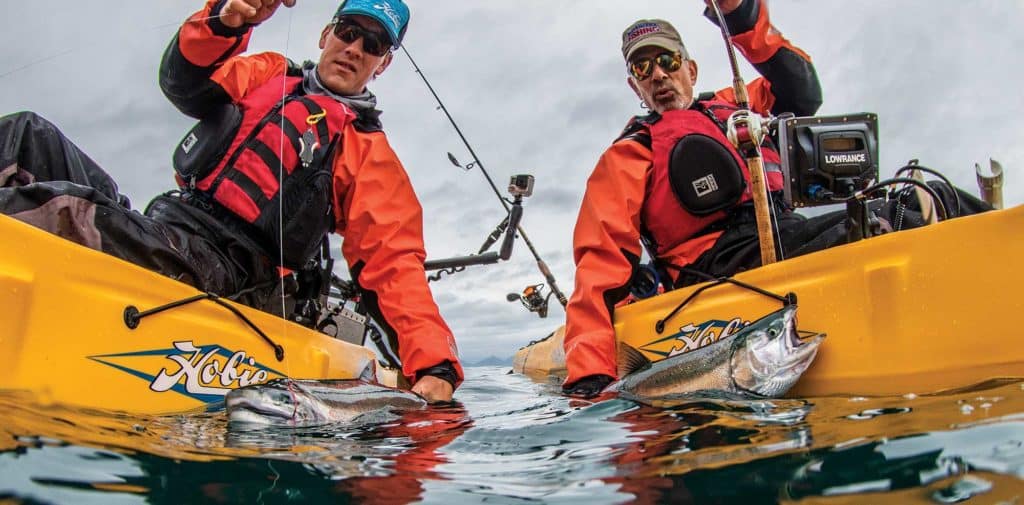
Alaska is, by nature, a wild place.
The capricious and often-volatile waters of the Gulf of Alaska can turn inhospitable in a hurry. But when quiet, it offers incomparable beauty and unforgettable fishing. A few intrepid kayak-angling enthusiasts joined me in Seward in August 2017 hoping for just such an experience. We found it.
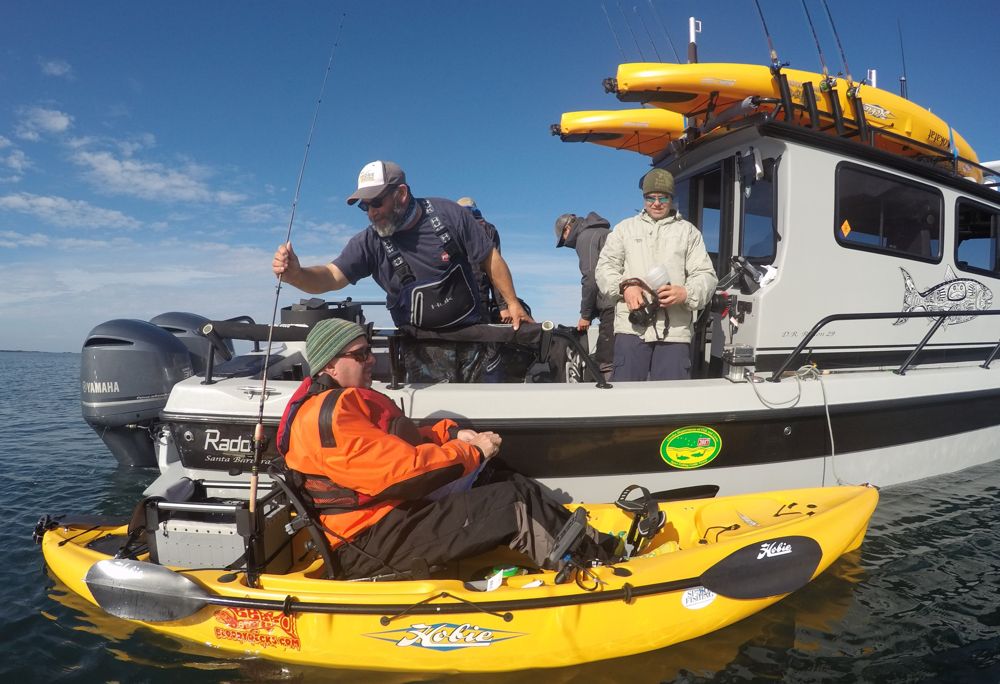
Trial Run
Andy Mezirow had fished from Hobie Outback kayaks in warmer climes, such as Panama, catching yellowfin tuna, cubera snapper and other brutish beasts. So, thought the Seward, Alaska, charter captain: Why not here?
Mezirow already knew the fundamentals of mothership-based kayak-angling, and he had the mothership: his 32-foot custom-built, twin-outboard-powered Radon, Gray Light, which carries his light-tackle clients into outer Prince William Sound on day trips and multiday/overnight trips.
Mezirow needed only to add a fleet of Outbacks and racks on his boat to carry them.
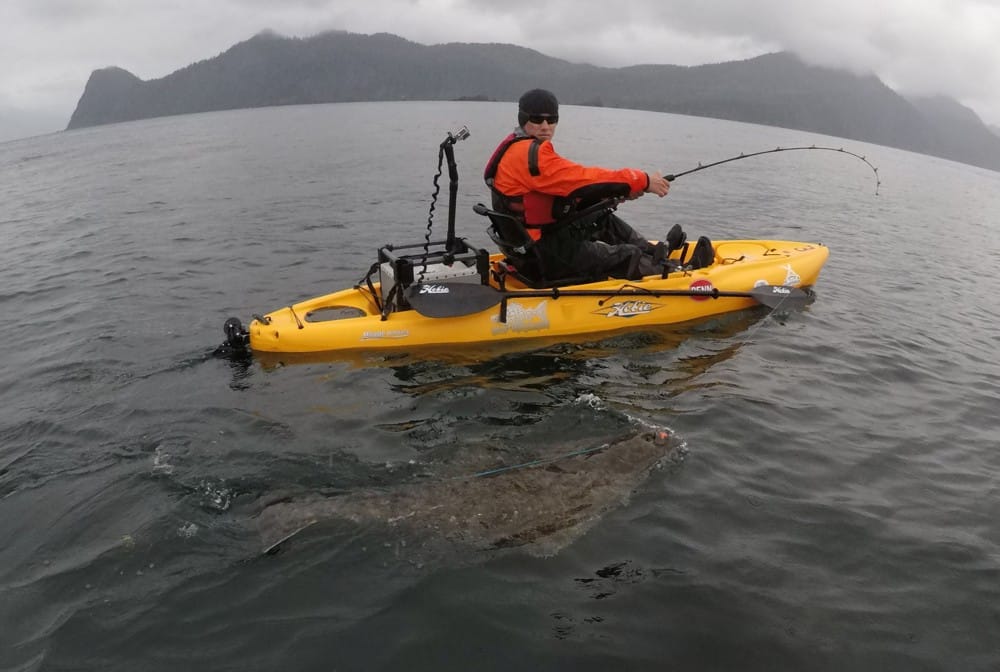
Once his five Outbacks arrived, in summer 2017, Mezirow contacted me, and we organized a little expedition as a trial run on what he planned to start offering to clients: serious Alaska kayak-fishing adventures.
So in August, I met up in Anchorage with Hobie’s Morgan Promnitz and Keeton Eoff, and (with his drone and underwater cameras) Adrian Gray, who oversees creative, production and design for the International Game Fish Association.
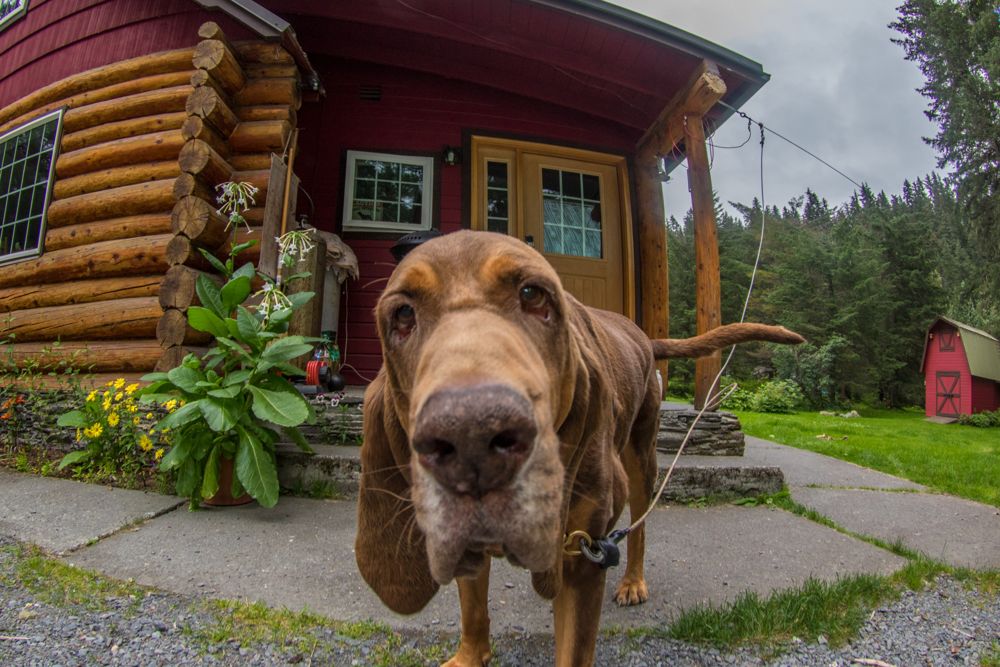
The following day, in Seward, we helped Mezirow get his ducks and Outbacks in a row. No one can set up a fishing kayak more easily and skillfully than Promnitz, and Mezirow already had everything on hand that each kayak-angler might need: Hobie Mirage pedal drives, Lowrance GPS/color sounders, H-Crates for storage with additional rod holders, jaw grippers and so on. (Each of us had brought a waterproof, handheld VHF radio.)
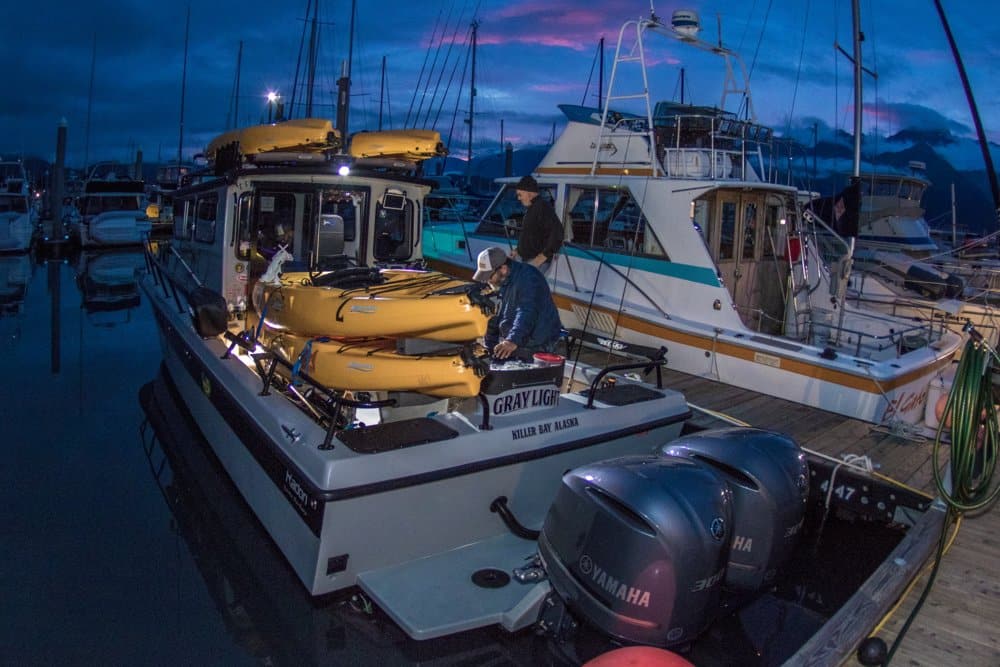
Coho Among the Kayaks
After loading the kayaks and a lot of fishing gear onto Gray Light, we headed out only as far as lower Resurrection Bay, 15 or so miles south of Seward — more as a run-through to be sure the process would go smoothly on the upcoming overnight trip than a serious fishing outing.
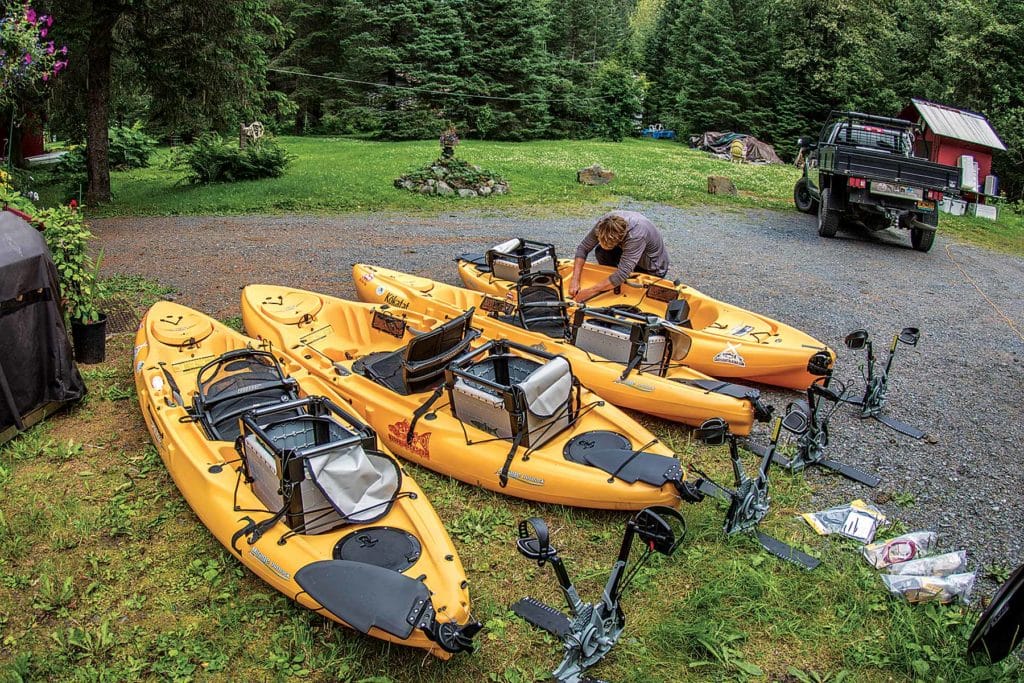
But when silver salmon are as thick as they proved to be in the quiet cove where Mezirow stopped and slid the Outbacks into the water, well, it’s pretty tough not to move into serious-fishing mode.
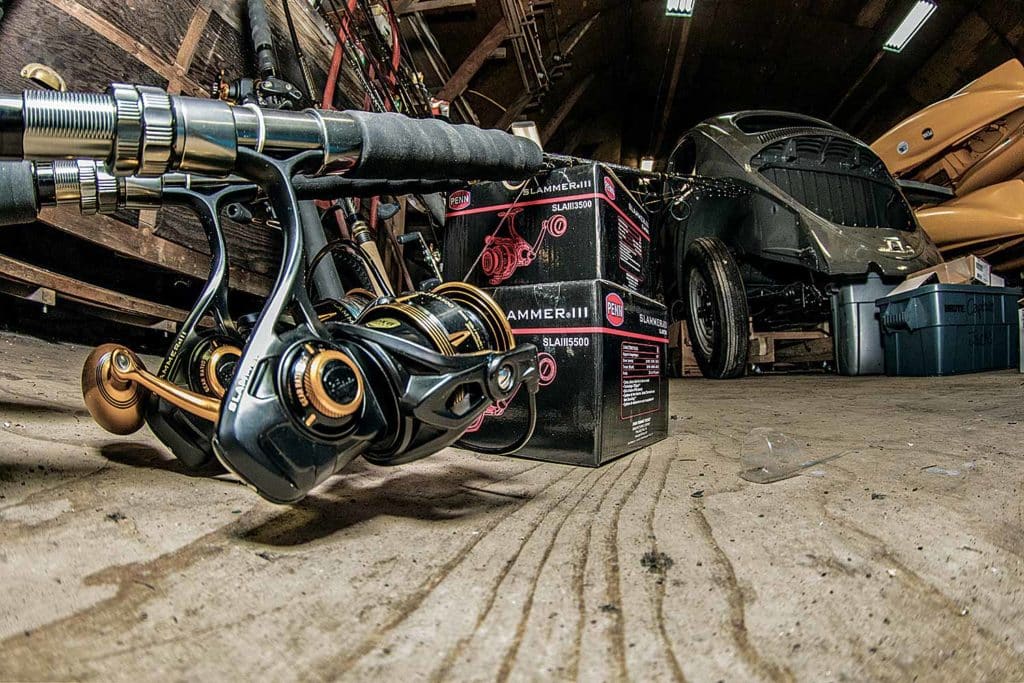
We began by slow-trolling chunks of herring, each on a single snelled hook with a long, light mono leader below a 2-ounce sinker. The pedal-powered kayaks are perfect for easy trolling in such a situation, and shortly — once we located the fish, in a thick school just off the rocks in 40 to 60 feet of water — we all began hooking up quickly.
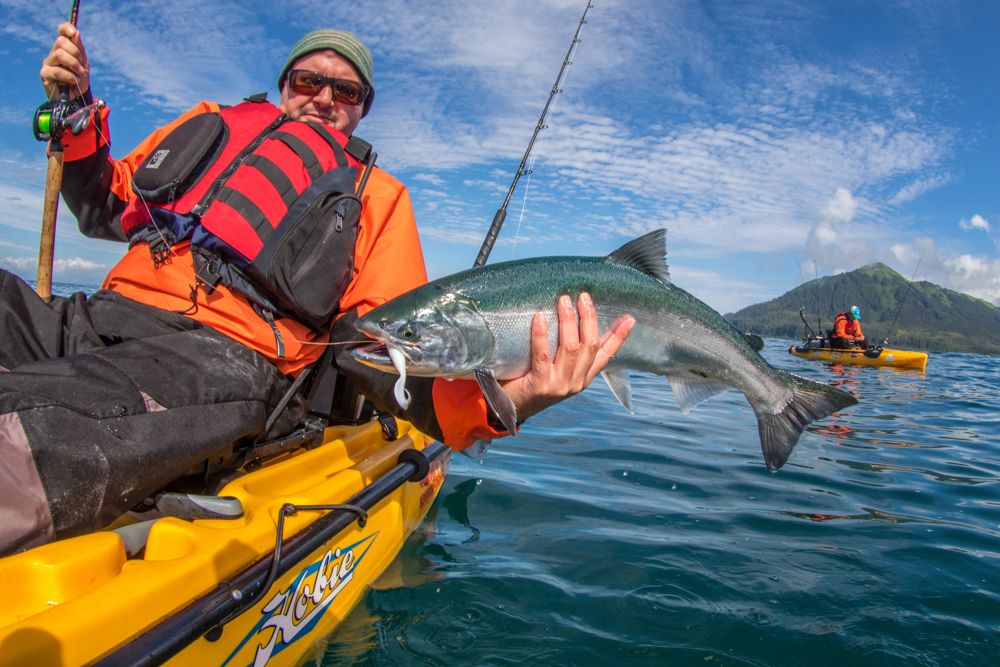
I recalled with some amusement the many trips, years back, when anglers fretted about exacting just the right spin to their plug-cut herring baits. Here, we simply, haphazardly ran a light-wire hook through a small chuck of herring; that was all it took.
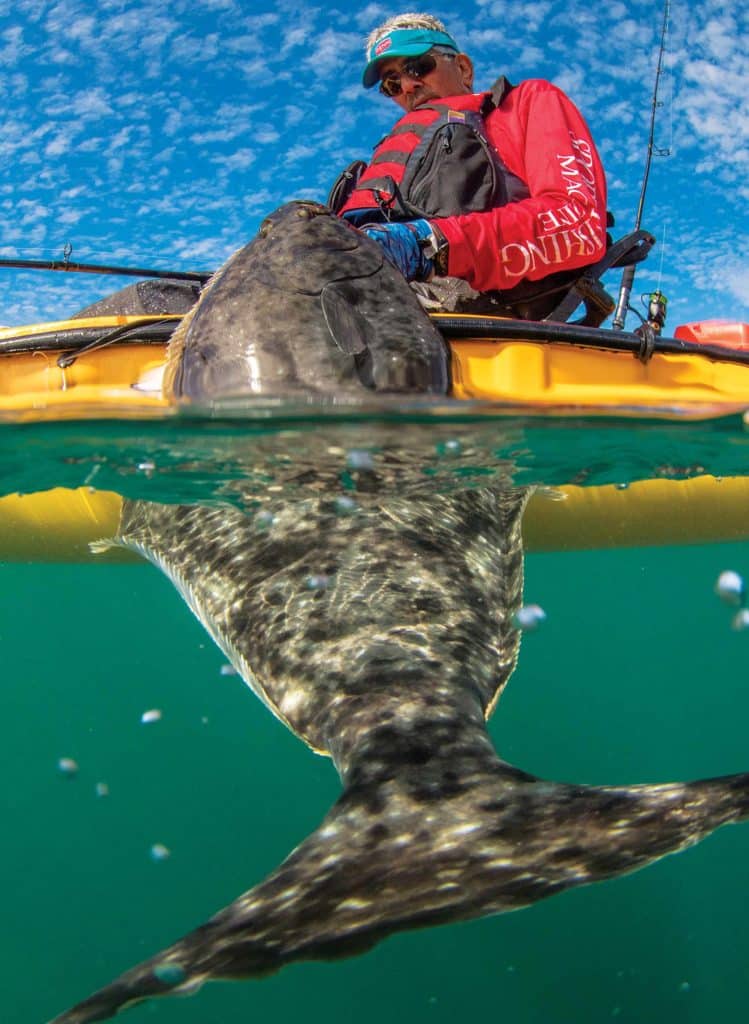
For a couple of hours, Keeton, Promnitz and I enjoyed the action, often with two or even all three of us hooked up simultaneously, as the spirited 6- to 15-pound coho (silvers) cartwheeled from the surface among the kayaks. The fact that we hooked the salmon on small baitcasters and spinning gear spooled with 15-pound braided line added to the excitement. As always, this is great sport from any deck, but it’s really hard to beat being right in the middle of the action at water level.
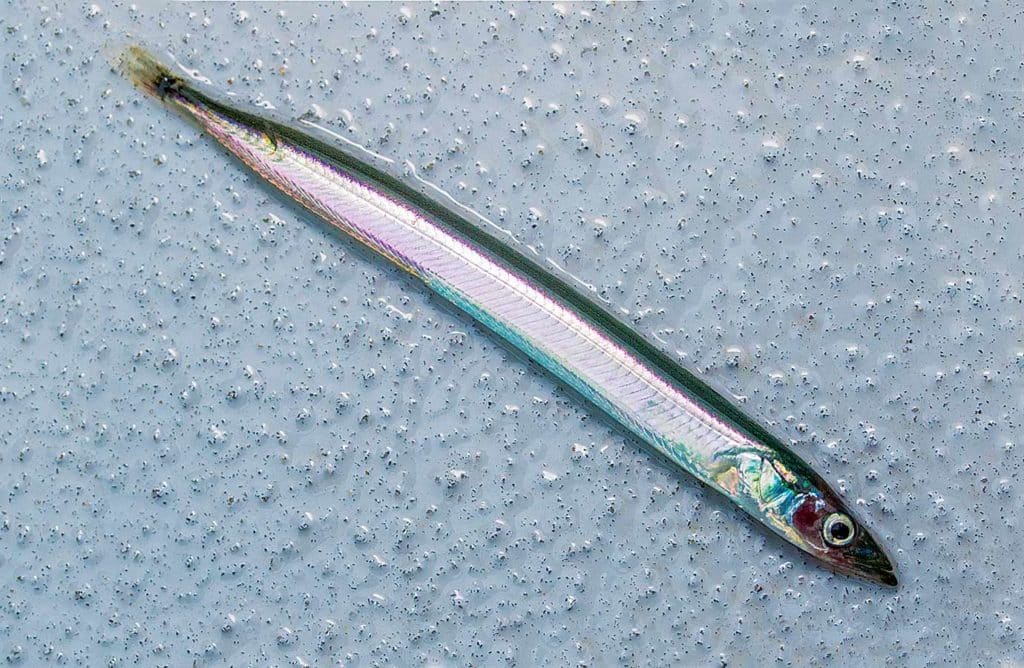
The salmon gave us little time to think about much else, including the on-and-off drizzle, so typical of this neck of the woods. Fortunately, we had good protection from the moderate breeze and, bundled in Kokatat paddling suits, none of us felt chilly.
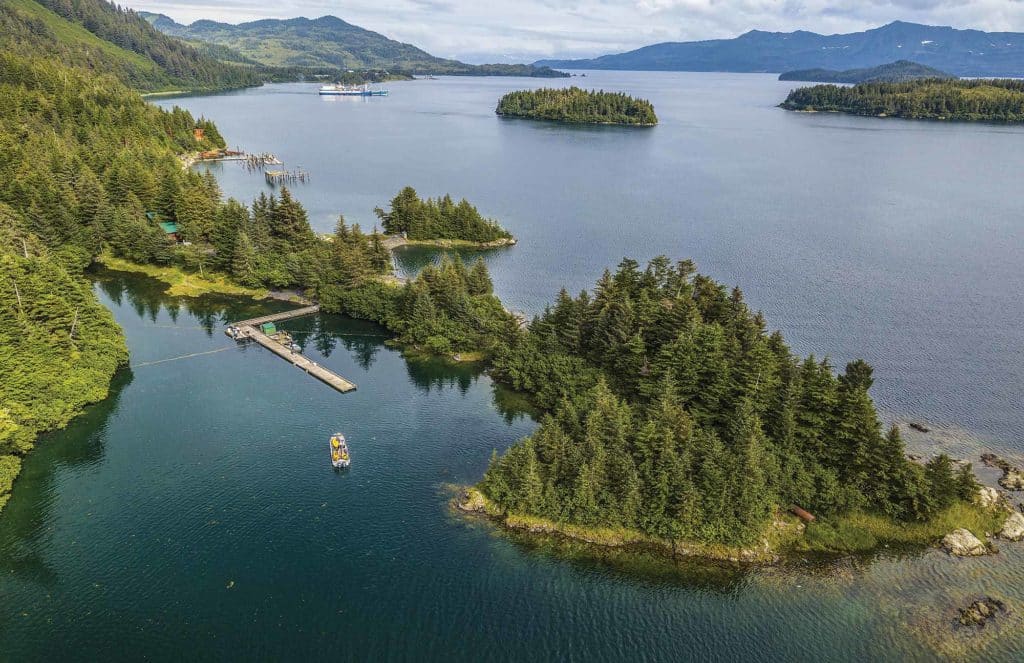
Flat Water, Nonstop Hookups
We returned to Seward, where, in our fabulous cottage on Bear Lake, we cooked up fresh silver salmon for dinner. Since even in mid-August it remained light until nearly midnight, we didn’t wait for darkness to hit the sack. Early the next morning, we headed to the harbor to make the two-and-a-half-hour run out to Montague Island. We planned to fish there and overnight at Port Ashton Lodge on Evans Island to the northwest.
As we finished sipping coffee and tinkered with tackle, we took in the spectacular seascapes while Gray Light headed east out of Resurrection Bay. Meanwhile, the iron-gray low clouds gradually began giving way to blue skies.
By the time Mezirow throttled back just off an extensive gravel beach along Montague, a glorious, clear, calm morning held immense promise. In short order, the anglers in their little plastic boats began trolling much as the day before but not bothering with bait this time; rather, we simply threaded a white or chartreuse 4-inch Gulp! Swimming Mullet onto the hook and fished that. Catching limits of silvers proved a no-brainer, and we released many over the next few hours, hooked salmon leaping unpredictably all around the kayaks.
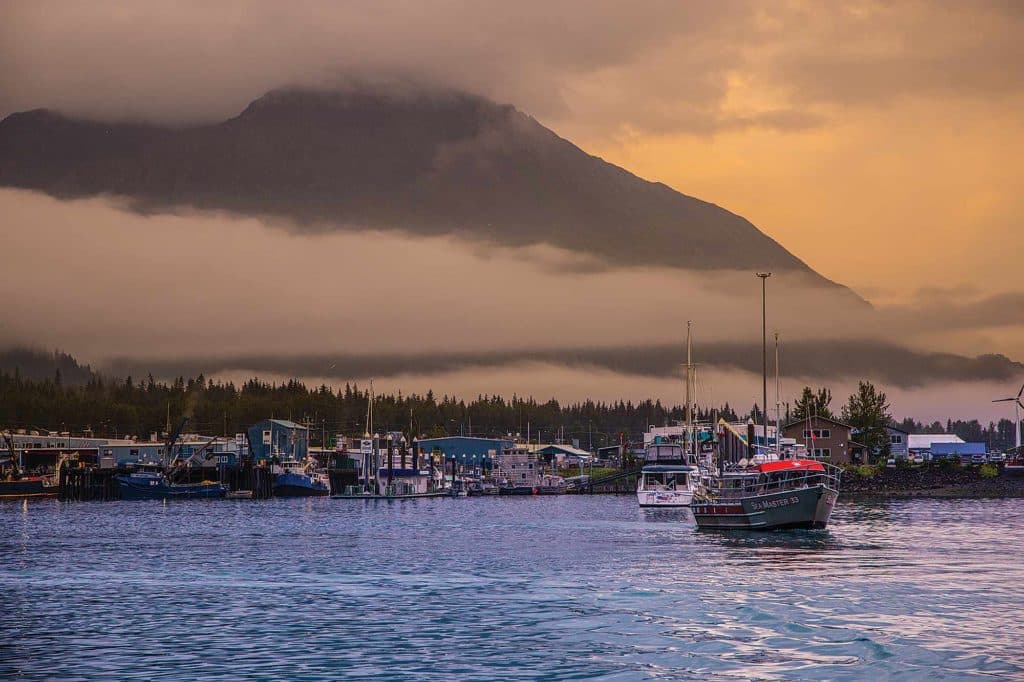
A number of small halibut, to 35 pounds or so, crashed the salmon party. I found one flattie of at least 30 pounds to be a real handful on the 15-pound braid.
After several hours of comfortable, easy fishing and nearly nonstop action, we returned to the mothership, where we loaded up the kayaks. As Mezirow steamed away, three hungry anglers worked on a late lunch.
Given that we were already into the afternoon, the captain decided that rather than put in again at another spot, we’d make the run to Port Ashton Lodge where we could rerig, recharge, clean up and once again eat our fill of fresh grilled salmon — and halibut — and be ready for an early start the next day.
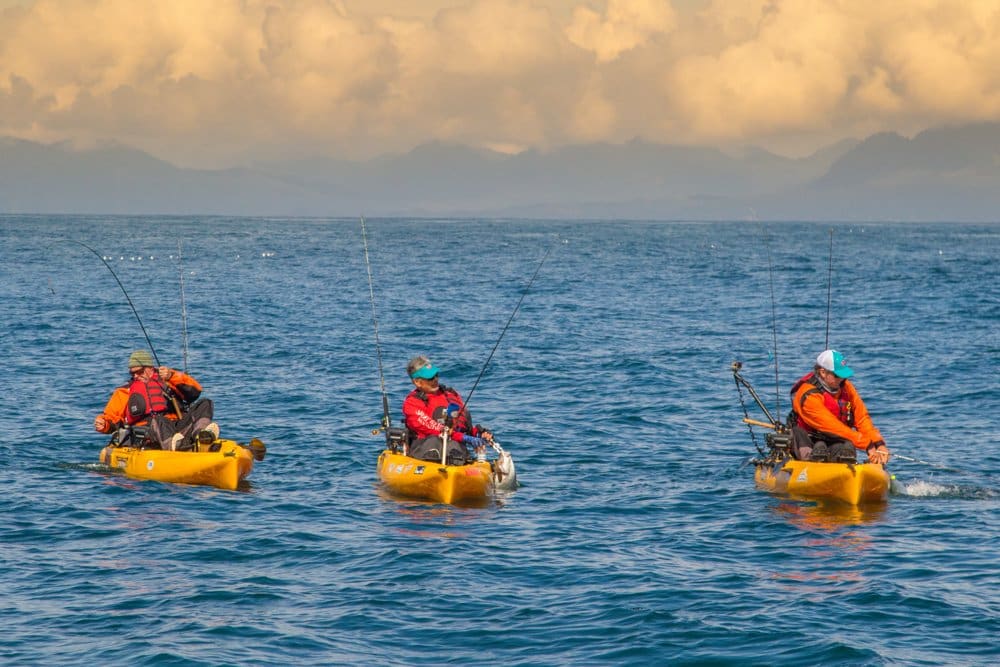
Whole Different Day
The word “remote” hardly does justice to the modest lodge on Evans Island. There, lodge owner Lia Talvi helped us haul our gear from the dock to the waterside cabin where we would crash that evening. (The main lodge already had guests booked in it.)
Since we hadn’t expected five-star digs and were staying only a night, the austere cabin worked out fine — and was a damn sight better than sleeping on the boat. Because it was right at the edge of Sawmill Bay, we could marvel at the sight of pink salmon leaping pretty much everywhere we looked.
Next morning, we were ready to tackle some serious halibut. No shortage of places in this part of Prince William Sound offered serious halibut action. But with a glitch in one outboard engine to slow us down, Mezirow decided to take us to Prince of Wales Passage, just around the corner from the lodge.
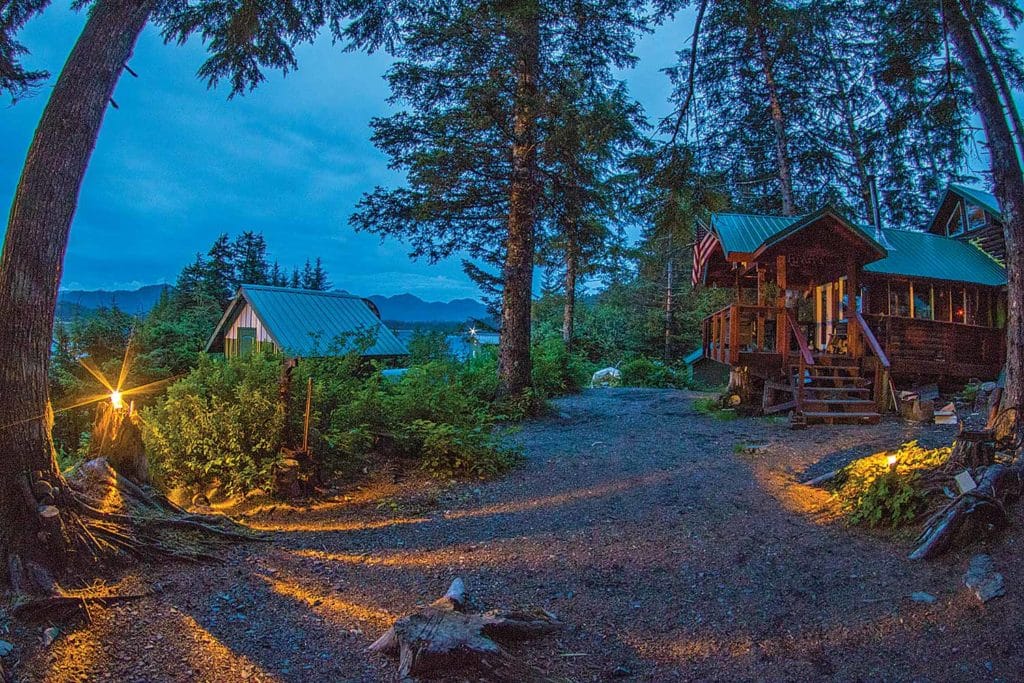
This outing turned out to be considerably different from the day before in just about every respect. For one thing, the warm, sunny, calm conditions had deteriorated to (the more typical) leaden skies intermittently spitting drizzle down upon us. The breeze had picked up, and the warmth of our Kokatat paddling suits proved welcome. Fortunately, by Alaska standards, the wind remained light enough to put only a light chop across the yawning pass. So away we went.
Right away, another notable difference from the day before made itself felt. Here, we faced a strong current that continuously wanted to push the kayaks out the yawning passage, past the anchored Gray Light. As in so many kayak-fishing situations over the years, I was again consciously grateful for the ingenious pedal system Hobie uses.
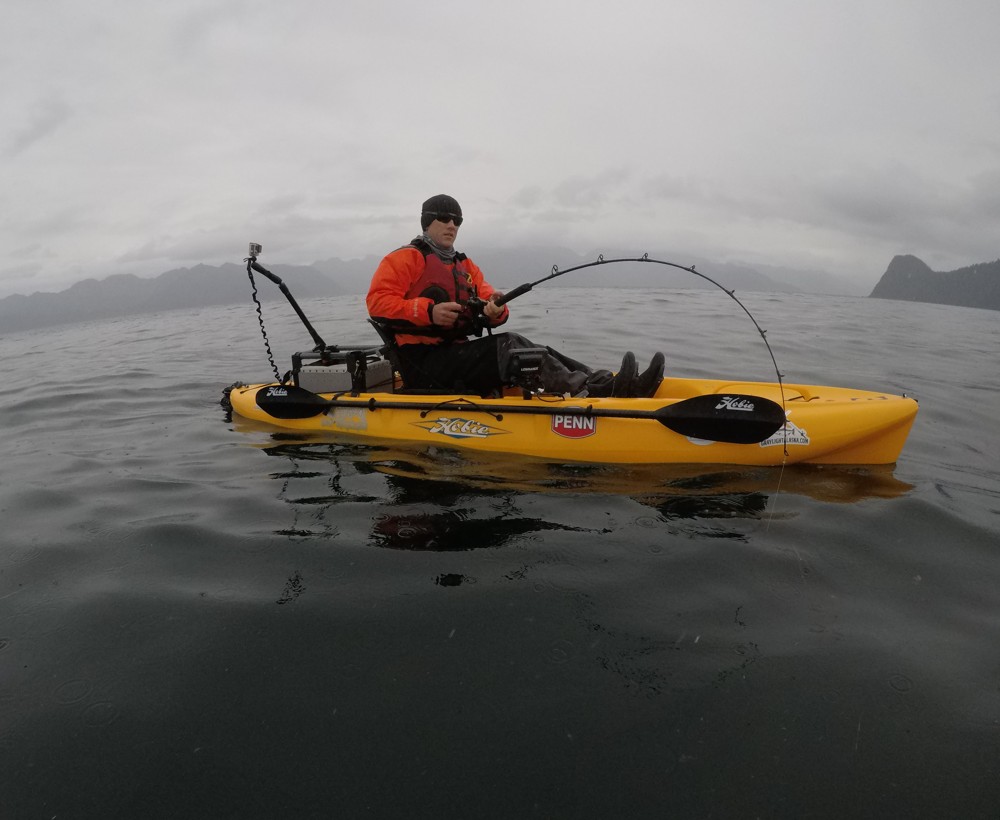
Little Boats, Big Halibut
We needed to keep pedaling most of the time to remain within shouting distance of the mothership. With all anglers in pretty good shape, doing so, as we dropped lines down, wasn’t an issue. However, if we had had to rely on paddles as our only means of locomotion, we would have done just that — paddled, and not fished.
We had fished clear shallows the previous day, but now we were dropping into 120 to 200 feet of water — in a current. We managed to drop fairly heavy lead-head and metal jigs down to the bottom. And as Mezirow had promised, we needed only do that.
After pulling up a couple of rockfish, we started hooking the real thing: barn-door flatfish. Whereas light rods and running, jumping fish characterized yesterday’s action, on this morning, anglers bobbed about in the yellow kayaks, their heavier rods and reels (Penn Slammer IIIs and Fathom Lever Drags with 50-pound braid) bent double, hard over on larger fish. Trying to winch up a powerful halibut from deep water in a strong current constitutes one hell of a challenge for a kayak-fisherman.
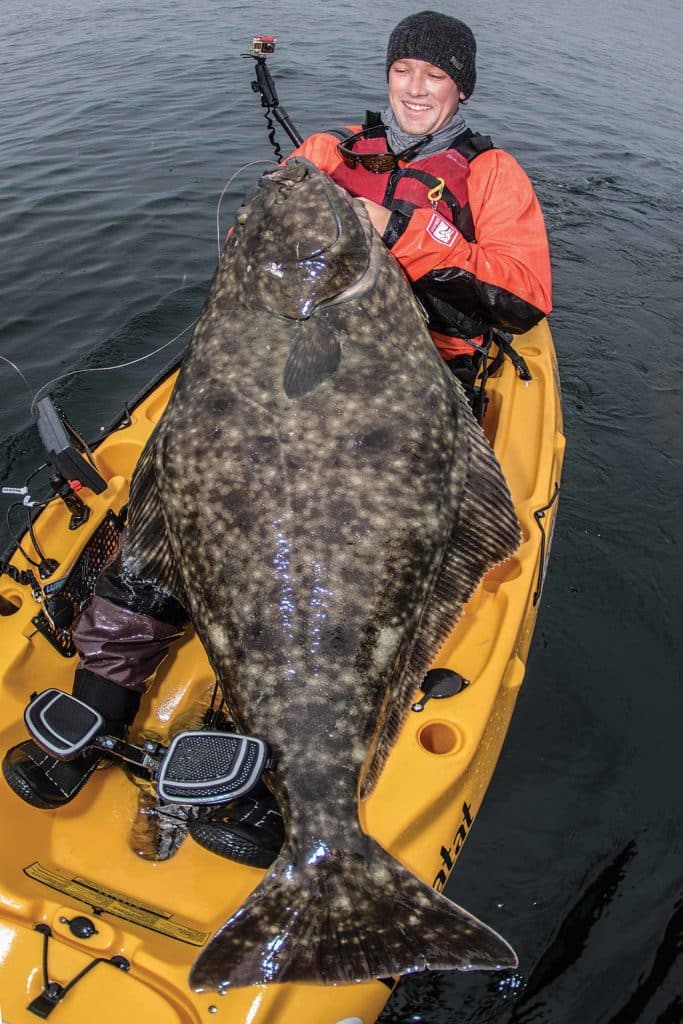
All three anglers met that challenge, often multiple times over the course of that morning. The big flatfish varied, with some from 40 to 50 pounds to the 70- to 80-pounder that Promnitz bested. (He managed to pedal the 100 yards up-current to the anchored Gray Light, where Mezirow planted a flying harpoon into the fish to land it.)
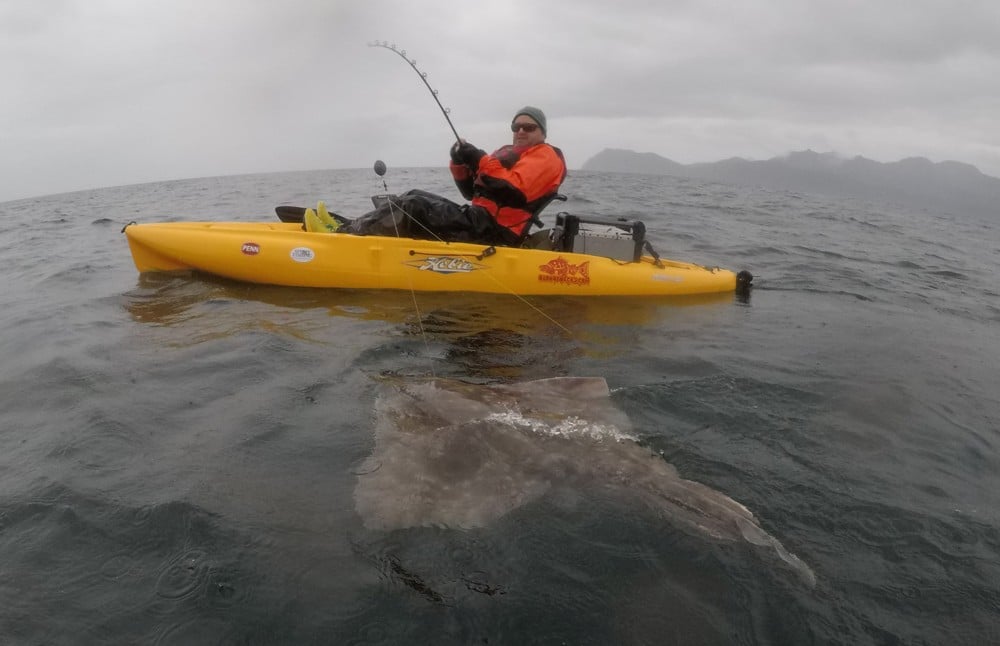
That afternoon, heading back to Seward, we were able to avoid any really nasty water, and — despite running on only one engine — hit the docks around suppertime. I think we all shared being tired but ultimately satisfied, with a sense that our overnight adventure seemed like more than just two days.
That’s not too surprising, I guess: Alaska is a wild place — a big place, and one not easy to reach. But the opportunity to fish Alaska from a kayak has become more than just a wild dream, and it has to qualify as an ultimate bucket-lister for hardcore enthusiasts.
Planning an Alaska Kayak-Fishing Adventure
When: Late May to early September
Best weather conditions usually occur in July through mid-August, but perfectly calm periods can happen in June and the latter part of August as well.
Where: Seward, Alaska
This is where Gray Light is based. The scenic port town is a two-and-a-half-hour drive south of Anchorage. There are shuttle, bus and train options from Anchorage, but renting a vehicle is likely to be the most convenient. Best to plan some lay days to take in some of the amazing hikes in this realm of peaks and glaciers.
What: Kayak-fishing
This will be the first full year of kayak-fishing trips for Capt. Andy Mezirow. He’ll be offering long-range trips of two to five days, including overnights at Port Ashton Lodge. Pricing varies by the number of anglers, from two to four (at most). There is the option to devote days on such outings to nonfishing activities as well, such as touring glaciers and watching wildlife from the kayaks.
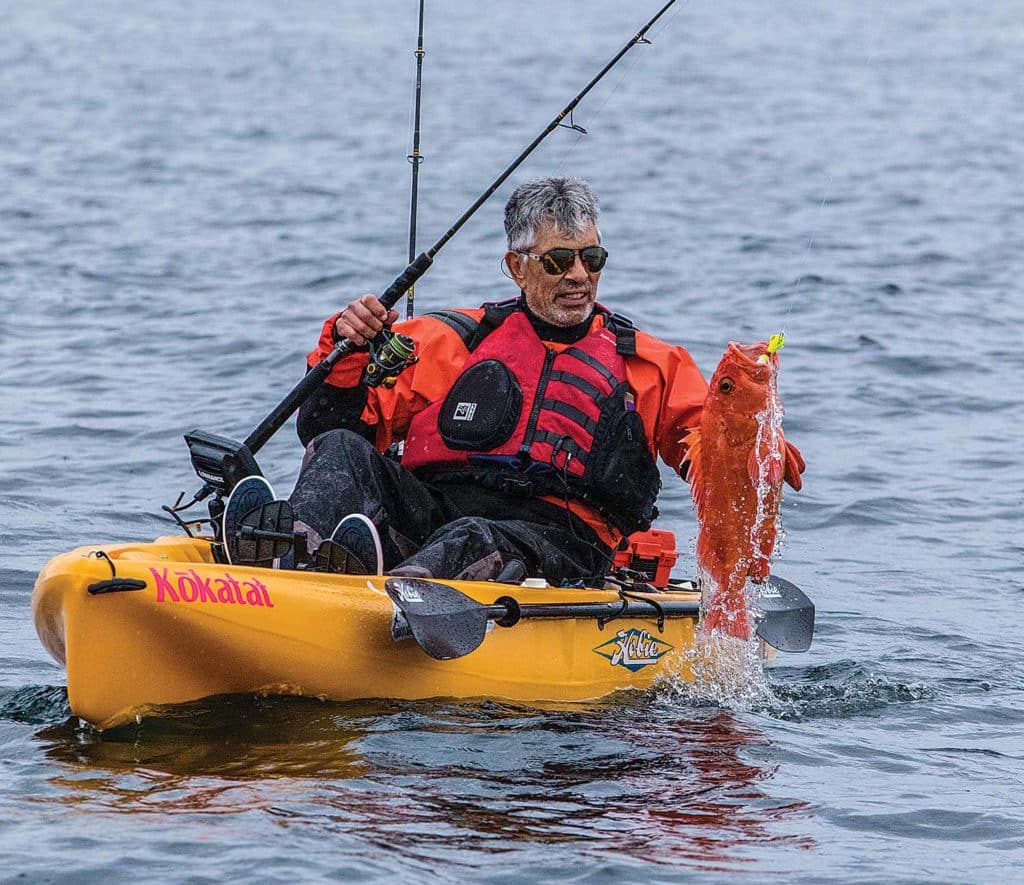
Mezirow provides the newest-style Hobie Outback kayak with Mirage-Drive pedal unit, PFDs, all tackle (though anglers are welcome to bring their own), lip grippers (though if you have a Boga-Grip, I’d bring it), paddling suits, Lowrance color sounder/GPS units, handheld VHF radios and a complete safety kit on each kayak.
You’ll need to provision your group of anglers in Seward with food and drink both for days on the mothership and kayaks; you can do the same for overnights or arrange to dine at the lodge each evening. (Mezirow asks that anglers not bring bananas or anything resembling them.) Also remember to purchase Alaska fishing licenses.
Going without a small waterproof camera would be a big mistake. I used a GoPro Hero 6, and it worked fabulously.
Finally, if your group is keen to do this but not sure if you’re up on your sit-on-top kayak skills, Mezirow will arrange a full-day orientation with a local kayak guide before a trip.
For More Information:
Gray Light Fishing Charters in Seward; 800-566-3912; graylightalaska.com
We stayed at the Cottage on Bear Lake, and highly recommend it. Call Cathy Weiford at 907-362-1072. We also spent a night at Beach House Rentals (907-362-2727), reasonably priced and located just south of Seward. Starting this year, Mezirow expects to have a fully furnished guesthouse also, as well as an option to stay at the Gray Light Lodge, 7 miles out of Seward.








